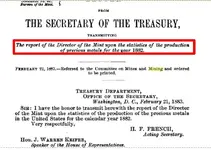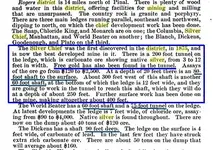For reference, and further discussion...

... here's a list of 99 clues I saved from an old post....by Peter Esposito I think...
It credits most of the original sources.
The Lost Dutchman Mine
99 Clues !
1) There are three big peaks above the mine to the west. (Bark to Spangler)
2) A north running canyon. (Waltz to Petrasch)
3) The north running canyon is filled with potholes. (Gassler)
4) There is a stone wall in a shelving cave near the mine. (Mitchell)
5) The rays of the setting sun will shine into the tunnel mouth when the mine is open. (Mitchell)
6) The vein runs 400 feet down the mountainside. (Waltz)
7) Look for the shadow of Weavers Needle at 4 pm during the winter solstice. (Various)
8) No cowboy will find my mine. (Waltz)
9) Near the head of the gulch is an old stone cabin foundation directly opposite the mine. (Mitchell)
10) The trail is monumented with two stones, one on top of the other. (Bark)
11) Its high up, yet you have got to go down. (Deering to Chunning)
12) Look for 3 boulders shaped like wickiups high up on the side of a mountain. (Apache woman to Scholey)
13) Theres a spirit that sleeps near the mine 4 hours a day. (Apache Jack)
14) A funnel-shaped pit (Various)
15) There is a waterfall in the vicinity. (Robert Jacobs)
16) Say John, you have to go through a hole. (Deering to Chunning)
17) There is a symbol near the mine that contains a triangle, circle and crescent. (Diaz)
18) I marked the place with a frying pan placed on the middle peak. (Waltz to Petrasch)
19) There is a double pack horse trail that leads right up to the tunnel. (Herman Petrasch)
20) One needs to climb up about 40 feet to see Weavers Needle to the south. (Waltz)
21) Above the mine was a grassy ridge where we could leave the animals. (Waltz)
22) There is a cross cut into the side of the ravine above the mine. (Robert Jacobs)
23) Waltz covered the mine. He was afraid someone would notice it from the trail below or on the ridge across. (Aylor)
24) The shaft was 75 feet deep made in the Mexican style with flailing walls. (Bicknell)
25) Mine is on a well-terraced hill. Terraced like rice-paddies. (Peck)
26) Dutchman is 69 steps back and down in a ravine only about 50' wide and 200' long shaped like a "Y". (Williams)
27) Waltzs mine had an opening no bigger than a barrel. (Peck)
28) Two pits at the mine about 75 feet deep and a like distance across the top . (Bark)
29) Near the mine, perhaps covering the entrance, is a square rock with one elongated corner. (Peck)
30) Look for a triangle of Rocks. (Jacobs)
31) Just to one side of the mine is a square rock waist-high. (Williams)
32) The gravestone was located 250-300 feet due south of the mine itself and designated a specific crevasse between large boulders that one has to pass to locate the mine. (Petrasch to Synbad)
33) Three stones by themselves are the key to the mine. (Flores)
34) There is a line between two peaks that bisect the shaft. (B Holmes)
35) The hole is small and high up. (Yocum to Morrow)
36) The mine is a rat hole. (Walter Dixon to Dwyer)
37) Mine is on a little knob about 50 feet high at the very end of a peninsula. On this hill is a pile of rocksabout 10 feet away from the opening. (Erwin Ruth to Richard Peck)
38) The soldiers reported the mine as being a very small open cut or trench. (Chuck Aylor)
39) Go up out of a brushy canyon, over a flat and down into a pit. (Al Morrow)
40) Cave near headwaters. Needed rope to get in. (Geronimos great-grand daughter)
41) Tunnel opens onto a caynon floor. (Erwin Ruth)
42) When you find the mine you will be lying on your belly like everyone else who was ever there. (Smitty to Richard Peck)
43) All the old landmarks are still there. You can almost peek into the mine where the entrance has settled. The cave of hidden gold. (San Carlos Apaches 1965)
44) Dutchman was getting gold from a creek bed. There was a shaft in the bottom of the wash. (Clay Worst to Richard Peck)
45) Waltz described his mine as being high up, in an arroyo, and hidden by the natural contours of the land. From over the top of a low ridge you could see down the far side where there was a small clearing, an open hole and a mine dump. (Herman Petrasch)
46) The mine is so cunningly concealed that one could walk within a few feet and miss it. (Waltz)
47) On the steep slope 100 feet above them they spied two Indians breaking rock. (Waltz to Julia Thomas)
48) I had to climb up a small hill from the mine entrance to see the Needle. (Waltz)
49) Its less than two miles from Weavers Needle toward the Salt River. (Phipps to Storm)
50) Weavers Needle was nearby in plain sight. (Apache boys to Barry Storm)
51) Weavers Needle, Four Peaks, a river and the horses head could be seen from the mine. (Al Morrow)
52) The mine was on a twelve foot high ledge, the mine was an open hole and the mine was on the apex of a ridge.
53) The mine is close to a cave and is high up on a ledge. Petrasch spent years searching the canyons looking for a cave or an opening high up. (Richard Peck)
54) Waltz mine is on a twelve foot high shelf. (Synbad)
55) Near the mine is a face that looks right at the mine. (Storm)
56) A Sphinx overhangs and dominates the mine area. (John Reed)
57) Waltz told of a natural stone face sitting upon the end of a canyon below his mine. (Storm)
58) Up above the mine was a cliff like a horses head with one ear laid back. (Storm)
59) The mine was in a northerly direction from a sharp peak. (Aaron Mason)
60) The mine is right out in the open,. You could walk right over it and not know you were there. (John Spangler)
61) About 20 steps above a spring is the Dutchmans mine. ( Williams)
62) Mine is located near three natural water tanks in a canyon, one below the other, a short distance from the mine. (Indian to B Holmes)
63) Mine is near the head of a gulch. There is a small spring there with sufficient water for household use. (Aylor)
64) 39 steps to agua. 69 stepd to the mine. (Ruths Eagle Head Map)
65) Mine is in a draw that is well hidden. (Jacobs)
66) The mine lies in the middle of two oblong outcrops that run north south and are above the waterfall. (Stevens)
67) The mine is located in a ravine on the side of a canyon wall. (Conatser)
68) In a steep climbing arroyo high on a mountainside. (Morrow)
69) The mine is in a cave, but the entrance is sealed. (Diaz)
70) Gold buried in a cave in the Superstitions. (Geronimo to soldier at Ft Sill)
71) Indians always spoke about a cave. Mention the mine and they would say, no, the cave. Cave at base of cliff in a little canyon. (Peck)
72) Ruth described the junction of two canyons, one running north south flanked by high cliffs on either side. The other was brushy and came in from the east. Above this canyon junction Ruth expected to find a Spanish marker which would show him the trail. (Storm)
73) If you pass the three red hills you have gone too far. (Waltz)
74) There is a tunnel on the side of the hill and a pit above past the three red hills. (John Kochera)
75) The mine is above a brushy boulder choked little canyon. (Walter Gassler)
76) Trail goes up past a long draw from west end of the south side of the range, down past a cliff into a canyon leading to the river. Take the first right hand canyon out on a flat area, then climb to the pit. (John Walker)
77) Mine is on a steep slope under the lip of a cliff. (Tommy Wise)
78) Mine was on a hillside. (Sims Ely)
79) The logs covering the shaft were set at an angle to conform to the slope of the terrain. (Walter Dixon)
80) The ruins of the rock house did not have a roof. (Weiss)
81) There are four spires above the mine, three tall ones and one smaller. (Spangler)
82) The tunnel entrance is supposed to be shaped like a bell. (Waltz to Thomas)
83) You cant approach the mine from above or below, but have to enter from the side. (Waltz)
84) No miner will find my mine. (Waltz)
85) Theres a trick in the trail. You have to go through a hole. (Joe Deering)
86) I placed a monument near the mine and then placed four similar monuments in the canyon below. (Deering to Chunning)
87) You have to work your way down a water crevasse. The approach to the mine is dangerous. (Weiser)
88)There was a dangerous foot path down to the mine. (Peralta)
89) The area where the mine was located was all broken up. (Ballesteros)
90) 200 feet across from the cave. (Adolph Ruth)
91) Deering said the hole you go thru was "in a rock". (Chunning to Barkley)
92) Mine was a volcanic vent . (Sims Ely)
93) Salazars survey objective was to find a cave with a wall and three red hills. (Livingston)
94) One went down on a rope or ladder, the other two stayed up above. (Granillo)
95) When asked about landmarks from the mine entrance Brownie Holmes hesitated and said "You will see nothing. Only space."
96) The Mexicans always posted a sentry in a brushy canyon below the mine. He could not see, but could always hear, the miners.
97) There was a little bit of brush on the slope above the mine. (Reed)
98) We will throw a stick of dynamite into the opening because of the trap. (B Holmes)
99) Once the rock house was found one would go back down the canyon checking the west side of the canyon wall. Once he found the ___________ he would then find the ___________ and .......................
Feel free to add any others you know of, so long as the source can be identified and verified.







 ....but I'll bet a few others besides Ted Cox have explored that area and the ridge and examined the workings since that 1882 report was published in 1883. There was some good info in that report.....
....but I'll bet a few others besides Ted Cox have explored that area and the ridge and examined the workings since that 1882 report was published in 1883. There was some good info in that report.....



